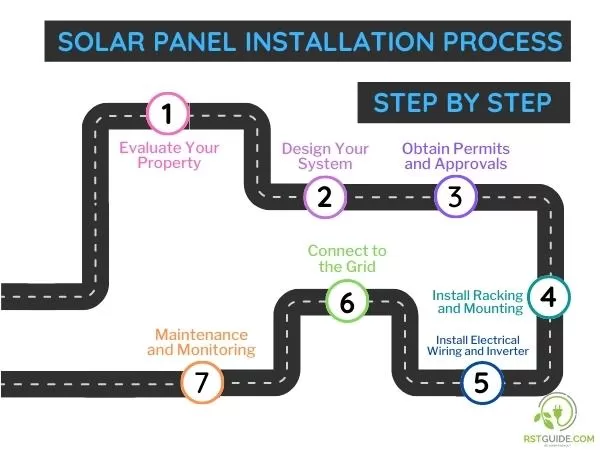Solar panels are a great way to harness the power of the sun to generate electricity for your home or business. They are becoming more and more popular due to their environmental benefits and the long-term savings they provide. However, many people are intimidated by the solar panel installation process. We will provide a step-by-step guide on how to install solar panels on your property.

Before we dive into the installation process, it’s important to understand some basic concepts about solar panels. The composition of solar panels includes photovoltaic (PV) cells that transform sunlight into electricity. These cells generate direct current (DC) electricity, which an inverter then converts into alternating current (AC) electricity. You can use this AC electricity to power your home or business, or even feed it back into the grid.
Step 1: Evaluate Your Property
When starting the solar panel installation process, first examine your property to see if it’s suitable for solar panels. Take into account the following factors:
- Sunlight availability: Solar panels need direct sunlight for electricity generation. Ensure your property gets ample sunlight daily.
- Roof orientation and pitch: Installing solar panels on a south-facing roof with a 15 to 40-degree pitch is most effective.
- Shade: Shaded areas can drastically decrease solar panel efficiency. Assess your property for shade from trees, buildings, or other obstacles.
Step 2: Design Your System
Once you’ve determined that your property is a good fit for solar panels, it’s time to design your system. This involves determining the size of the system you need, the number of panels required, and the location of the panels on your roof. A solar professional can help you with this step.
Step 3: Obtain Permits and Approvals
Before you can install your solar panels, you’ll need to obtain the necessary permits and approvals from your local government and utility company. This typically involves submitting an application and providing detailed plans and specifications for your system.
Step 4: Install Racking and Mounting
After securing permits and approvals, install the racking and mounting system. Stabilize the panels on your roof with the racking system, using anchored bolts and brackets.
Step 5: Install Electrical Wiring and Inverter
Once you’ve installed the racking and mounting system, proceed with the electrical wiring and inverter installation. Connect the panels to the inverter using the wiring, allowing the inverter to convert the DC electricity produced by the panels into usable AC electricity for your home or business.
Step 6: Connect to the Grid
Once your solar panels are installed and connected to the inverter, it’s time to connect your system to the grid. Install a meter to measure the electricity your system generates and feeds into the grid. Once done, start producing electricity and earning utility bill credits for excess energy.
Step 7: Maintenance and Monitoring
Finally, it’s important to regularly maintain and monitor your solar panel system to ensure it’s operating efficiently and effectively. This includes cleaning the panels, checking the wiring and connections, and monitoring your energy production.
Conclusion
Installing solar panels on your property can be a great investment in both your financial future and the environment. By following the step-by-step guide outlined in this article, you can ensure a successful and efficient installation process that will provide you with a reliable source of clean energy for years to come.
FAQs
How long does it take to install solar panels?
- The installation process can take anywhere from a few days to a few weeks, depending on the complexity of the system and the size of your property.
How much does it cost to install solar panels?
- The cost of solar panel installation varies depending on a number of factors, including the size of the system, the location of your property, and the cost of labor and materials. On average, the cost can range from $10,000 to $30,000.
Can I install solar panels myself?
- While you can install solar panels on your own, it’s advisable to seek professional help, especially if you lack experience in electrical and roofing work. Hiring a professional ensures a safe and accurate installation of the system.
How long do solar panels last?
- Solar panels are designed to last for 25 years or more, but their lifespan can vary depending on factors such as weather conditions and maintenance.
Can I still use electricity from the grid if I have solar panels?
- Yes, you can still use electricity from the grid if you have solar panels. Your system will automatically switch between using electricity from the panels and electricity from the grid as needed.